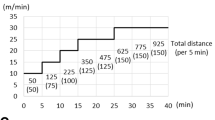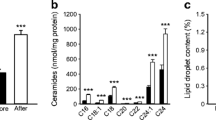Abstract
Previous observations showing that basal heat production rates and glucose metabolism were reduced inmdx mouse skeletal muscles incubated in vitro led us to study the components of total energy expenditure by open-circuit indirect calorimetry in the intact, free-movingmdx mouse. Our purpose was to verify if themdx mouse exhibited whole-body alterations in energy metabolism. The results revealed that total and basal energy expenditure, as well as spontaneous activity, energetic cost of activity, and, therefore, energy expended in relation to activity were not significantly different in C57B1 / 10 (control) and in dystrophic (mdx) mice. In contrast, the thermic effect of food was 32% larger inmdx than in control mice and was accompanied by significant differences in postprandial glucose and lipid oxidation. The present in vivo study could not show a direct demonstration that impaired glucose metabolism by skeletal muscles participated in this phenomenon. However, since postprandial glucose metabolism by skeletal muscles contributes a significant part of the thermic effect of food, the present data are in line with previous studies in vitro that show thatmdx mouse skeletal muscles probably suffer an impaired control of their energy metabolism.
Similar content being viewed by others
References
Anderson JE, Bressler BH, Ovalle WK (1988) Functional regeneration of the hindlimb skeletal muscle of themdx mouse. J Muscle Res Cell Motif 9:499–515
Arahata K, Ishiura S, Ishiguro T, Tsukahara T, Suhara Y, Eguchi C, Ishihara T, Nonaka I, Ozawa E, Sugita H (1988) Immunostaining of skeletal and cardiac muscle surface membrane with antibody against Duchenne muscular dystrophy peptide. Nature 333:861–863
Ashworth A (1969) Metabolic rate during recovery from protein-calorie malnutrition: the need for a new concept of specific dynamic action. Nature 223:407–409
Bulfield G, Siller WG, Wight PAL, Moore KJ (1984) X chromosome-linked muscular dystrophy (mdx) in the mouse, Proc Natl Acad Sci USA 81:1189–1192
Carnwath JW, Shotton DM (1987) Muscular dystrophy in themdx mouse: histopathology of the soleus and extensor digitorum longus muscles. J Neurol Sci 80:39–54
Chinet A, Clausen T, Girardier L (1977) Microcalorimetric determination of energy expenditure due to active sodiumpotassium transport in the soleus muscle and brown adipose tissue of the rat. J Physiol (Lond) 265:43–61
Chinet A, Decrouy A, Even PC (1992) Ca2+-dependent heat production under basal and near basal conditions in the mouse soleus muscle. J Physiol (Lond) 455:663–678
Chinet AE, Even PC, Decrouy A (1994) Dystrophin-dependent efficiency of metabolic pathways in mouse skeletal muscles. Experientia 50:602–605
Dangain J, Vrbova G (1984) Muscle development inmdx mutant mice. Muscle Nerve 7:700–704
Dauncey MJ, Brown D (1987) Role of activity-induced thermogenesis in twenty-four hour energy expenditure of lean and genetically obese (Ob/Ob) mice. Q J Exp Physiol 72:549–559
Decrouy A, Even PC, Chinet A (1993) Decreased rates of Ca2+-dependent heat production in slow- and fast-twitch muscles from the dystrophic (mdx) mouse. Experientia 49:843–849
DeFronzo RA, Jacot E, Jéquier E, Maeder E, Wahren J, Felber J-P (1981) The effect of insulin on the disposal of intravenous glucose: result from indirect calorimetry and hepatic and femoral venous catheterization. Diabetes 30:1000–1007
Dunn JF, Frostick S, Brown G, Radda GK (1991) Energy status of cells lacking dystrophin: an in vivo/in vitro study ofmdx mouse skeletal muscle. Biochim Biophys Acta 1096:115–120
Dunn JF, Tracey I, Radda GK (1993) Exercice metabolism in Duchenne muscular dystrophy: a biochemical and31P-nuclear magnetic resonance study of mdx mice. Proc R Soc Lond [Biol] 251:201–206
Dupont-Versteegden EE, Baldwin RA, McCarter RJ, Vonlanthen MG (1994) Does muscular dystrophy affect metabolic rate. J Neurol Sci 121:203–207
Elia M (1992) Organ and tissue contribution to metabolic rate. In: Kinney JM, Tucker HN (eds) Energy metabolism: tissue determinant and cellular corollaries. Raven, New York, pp 61–80
Even PC, Nicolaidis S (1993) Adaptative changes in energy expenditure during mild and severe feed restriction in the rat. Br J Nutr 70:421–431
Even PC, Perrier E, Aucouturier J-L, Nicolaidis S (1991) Utilization of the method of Kalman filtering for the on-line computation of background metabolism in the free-moving free-feeding rat. Physiol Behav 49:177–187
Even PC, Mokhtarian A, Pelé A (1994) Practical aspects of indirect calorimetry in the laboratory animals. Neurosci Biobehav Rev 18:435–447
Even PC, Decrouy A, Chinet A (1994) Defective regulation of energy metabolism in mdx-mouse skeletal muscles. Biochem J 304:649–654
Garlick PJ (1986) Protein synthesis and energy expenditure in relation to feeding. Int J Vitam Nutr Res 56:197–200
Haymond MW, Strobel KE, DeVivo DC (1978) Muscle wasting and carbohydrate homeostasis in Duchenne muscular dystrophy Neurology 28:1224–1231
Henriksson J (1990) The possible role of skeletal muscle in the adaptation to periods of energy deficiency. Eur J Clin Nutr 44 [Suppl 1]: 55–64
Hoover-Plow J, Nelson B (1985) Oxygen consumption in mice (I strain) after feeding. J Nutr 115:303–310
Ianasescu V, Luca N, Vuia O (1976) Respiratory control and oxidative phosphorylation in dystrophic muscle. Acta Neurol Scand 43:564–572
Kemp GJ, Taylor DJ, Dunn JF, Frostickand SP, Radda GK (1993) Cellular energetic of dystrophic muscle. J Neurol Sci 116:201–206
Kleiber M (1947) Body-size and metabolic rate. Physiol Rev 27:511–541
Krieger I (1978) Relation of specific dynamic action of food (SDA) to growth in rats. Am J Clin Nutr 31:764–768
Lilling G, Beitner R (1991) Altered allosteric properties of cytoskeleton-bound phosphofructokinase in muscle frommdx mice with X chromosome-linked muscular dystrophy (mdx). Biochem Med Metabol Biol 45:319–325
MacLennan PA, McArdle A, Edwards RT (1991) Acute effects of phorbol esters on the protein-synthetic rate and carbohydrate metabolism of normal andmdx mouse muscles. Biochem J 275:477–483
Morrison SD (1967) The constancy of the energy expended by rats on spontaneous activity, and the distribution of activity between feeding and non feeding. J Physiol (Lond) 197: 305–323
Muntoni F, Mateddu A, Marchei F, Clerk A, Serra G (1993) Muscular weakness in themdx mouse. J Neurol Sci 120:71–77
Nishio H, Wada H, Matsuo T, Horikawa H, Takahashi K, Nakajima T, Matsuo M, Nakamura H (1990) Glucose, free fatty acid and ketone metabolism in Duchenne muscular dystrophy. Brain Dev 12:390–402
Olson E, Vignos PJ, Woodlock J, Perry T (1968) Oxidative phosphorylation of skeletal muscle in human muscular dystrophy. J Lab Clin Med 71:220–231
Takagi A, Shimada Y, Mozai T (1970) Studies on plasma free fatty acid and ketone bodies in young patients with muscular atrophy. Neurology 20:904–908
Tanabe Y, Esaki K, Nomura T (1986) Skeletal muscle pathology in X chromosome-linked muscular dystrophy (mdx) mouse. Acta Neuropathol (Berl) 69:91–95
Torres LFB, Duchen LW (1987) The mutantmdx: inherited myopathy in the mouse. Brain 110:269–299
Turner PR, Westwood T, Regen CM, Steinhardt RA (1988) Increased protein degradation results from elevated free calcium levels found in muscle frommdx mice. Nature 333:735–738
Vignos PJ, Lefkowitz M (1959) A biochemical study of certain skeletal muscle constituents in human progressive muscular dystrophy. J Clin Invest 38:873–881
Younkin DP, Berman P, Sladky J, Chee C, Bank W, Chance B (1987) TI 31P NMR studies in Duchenne muscular dystrophy:age-related metabolic changes. Neurology 37:165–169
Author information
Authors and Affiliations
Rights and permissions
About this article
Cite this article
Mokhtarian, A., Decrouy, A., Chinet, A. et al. Components of energy expenditure in themdx mouse model of Duchenne muscular dystrophy. Pflugers Arch. 431, 527–532 (1996). https://doi.org/10.1007/BF02191899
Received:
Revised:
Accepted:
Issue Date:
DOI: https://doi.org/10.1007/BF02191899




